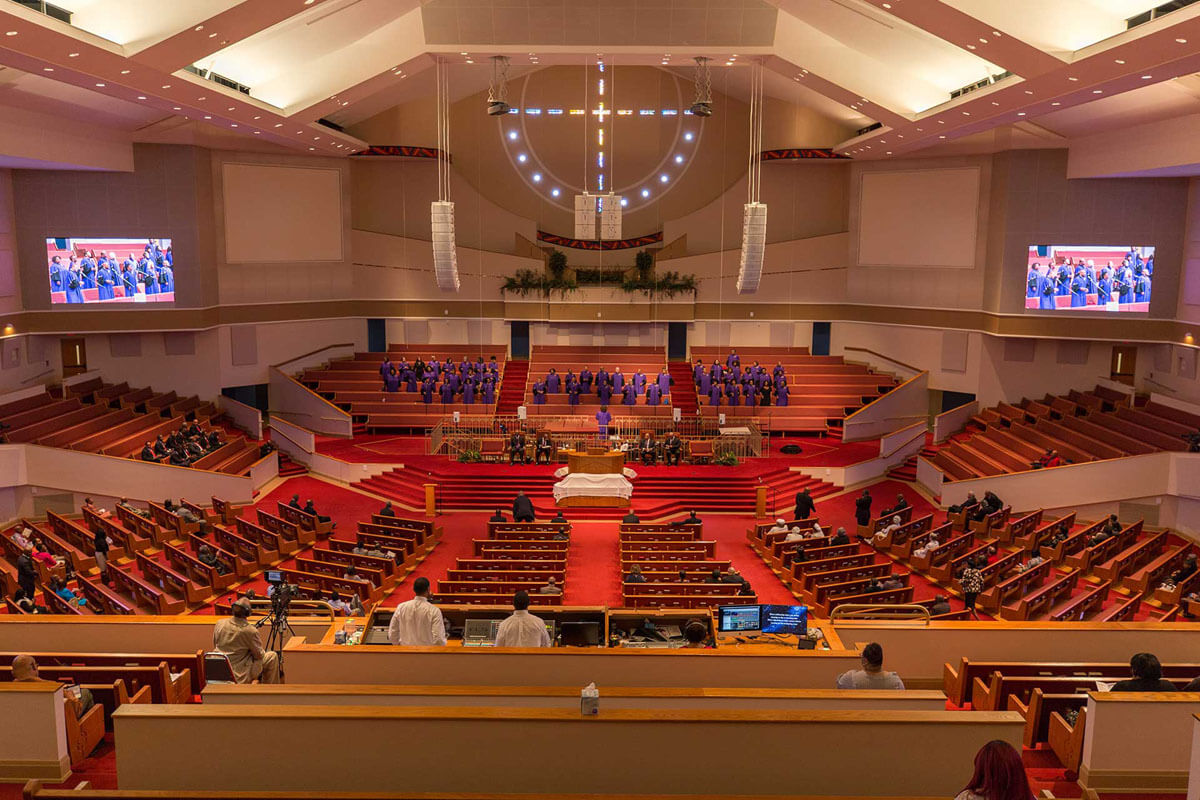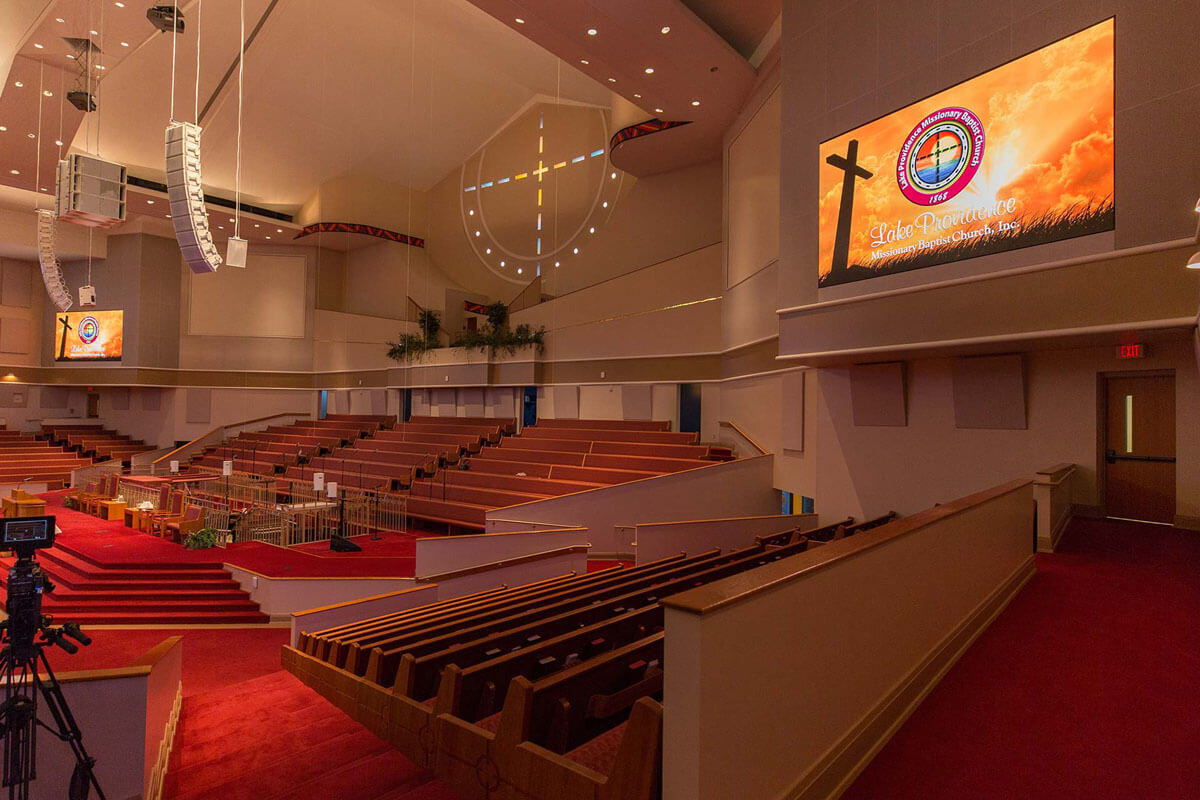When thinking about how to choose a display solution for your church, there are a variety of factors to consider, such as projection, television and LED Display. Experts suggest that you do more research on which technology works best for your church and turn to professionals and reliable resources for more support. Here are four main factors for you to take into consideration.
Have you ever thought about what content you are going to run on the screen? This is often not taken into consideration by lots of individuals when choosing pixel pitch, but it is a really important one to think about.
Let’s say you like to invest significantly in a LED display and choose a large format 10mx4m screen with a 3mm pixel pitch. The screen looks stunning in the demo’s but whenever your video switcher puts content on it, it looks a little blurry? What’s wrong? The answer is that you’ve gone past the realm of true HD towards 4K quality, but your video switcher hasn’t changed with it. If you send a 720p signal to a screen that has a resolution of over 2k, you will have to upscale the content to fit the screen, and each pixel won’t get used to its maximum capacity.
It’s important to consider the environment in which the technology will be housed when specifying display technology for a worship house. For example, if the worship house has a number of windows and therefore a high level of ambient light, the projection may not be bright enough. On the other hand, LED displays can be heavy, so structural considerations have to be taken into account if you’re comparing LED with projection.
There’s also the question of real estate: front projection becomes the solution when there isn’t enough space available for rear projection—By design, it means that the projector is in front of the screen, up over the audience or in the back of the worship center, which may or may not be a desirable compromise.

When deciding what pixel pitch to choose from, distance to the first row is another important factor to think over. A minimum ideal viewing distance from a screen with a 3mm screen is roughly 3 meters. Note that at 3 meters you will still see some pixelation of a 3mm pixel pitch screen, as it is the minimum ideal viewing distance, but it begins to disappear as you move backwards.
The cost increases when the pixel pitch is smaller. This is a very important factor, but you might be amazed at what’s available in your budget. There is a tipping point in any technology where it gets exponentially more expensive, but we have found that the price jumps as the pixel pitch decreases and even sub 2.5mm pixel pitch screens are quite reasonable as now they are of sizes in mass production. Ask for prices on different sizes, and you can see what the cost difference is. Projection isn’t necessarily cheaper than LED displays. Some people say that they can’t afford LED so they choose projection, but they want to do projection well and they have a lot of unshaded windows. A highly bright projector to fill a large screen in a high ambient light worship house can be expensive as well. An LED wall is a black surface, so the nice thing is that it can be relatively unobtrusive when not in use. As opposed to a projector screen, where there’s always the need to display content on it since it is a large white or gray surface. This comes in handy when a worship house wants to prioritize other scenic elements during production.
So when you consider an LED screen as a display solution for your church, how to choose the right LED display? There’re four essential factors to consider.
Since LED displays are often comprised of 0.5m square panels, each containing tens of thousands of RGB LEDs, they can be expensive. One important thing to realize is that pixel pitch (the distance between the centers of two adjacent LEDs) really matters. An LED wall with a pixel pitch of 0.7mm can be used to create a 1080p wall in a fairly small area (not much larger than a large-sized TV). A 4mm pixel pitch would require a size of about 8m x 4.5m to show a 1080p 16:9 image.
As LED walls are typically composed of individual panels, they’re not locked into a 4:3 or 16:9 aspect ratio. While you can build a wall that’s six panels wide and five panels tall or four by three, you’re not limited to those. So, you could just as easily build a wall that’s 16:9 or 10:7.
Because LED walls tend to be brighter than projectors and, to some extent, televisions, they can look very good on camera when shot with IMAG. This also comes with a shortcoming that lighting techs might be concerned with. Your LED wall is likely to be a large source of light that can balance or even overwhelm another lighting. A nice thing is that LED walls can be dimmed or brightened to a certain degree, but that’s something you need to consider in your planning.

![]()
At some point, your LED screens will require servicing, and this is where buying for cheaper price becomes a real problem. Manufacturers can start up overnight, produce LED panels, and then they can disappear just as quickly and you’re left with nothing to replace your LED modules, or you can’t fix them if they need technical support. For example, you may save $15,000 on your LED screen for your conference room, but now you have to buy a whole new one three years later.
Eventually, you don’t really save much. It seems every day there’re LED manufacturers promising to bring some spectacular technology to the world and it’s not vetted yet. Experts strongly suggest that churches do their research when they’re considering an LED wall purchase, and to turn to reliable sources for guidance. Work with an integration firm or a manufacturer that you can trust, and ultimately you’re getting a product that’s really going to serve the church well for years to come.
LED walls can be heavy after installed. They may have aluminum cases that provide stability and durability, but even light-weight metals get heavy in large enough quantities. It’s strongly suggested that you consult technical engineers before you assume that your wall or ceiling can bear the weight of a large LED wall. Hanging an LED wall correctly is a job for an expert.
This is one of the times that a professional rigger is worth their weight in gold. Using a rigger protects your investment in both your building and the LED wall itself. Doing the rigging correctly can also literally be the difference between life and death since LED walls can weigh hundreds if not thousands of dollars.
Finally, there’s viewing distance. Anyone who’s helped install an LED wall (or has even been to an event where one is used) can tell you that if you get too close, all those LEDs evenly spaced throughout your entire field of vision can really play tricks on your eyes and even cause dizziness. Make sure people will be viewing the LED wall from far enough away.
Note: please contact us if you found any information contained in the article violating your copyright.